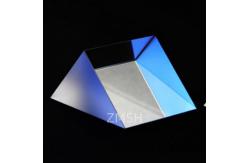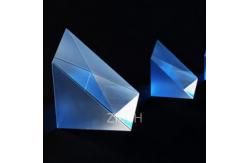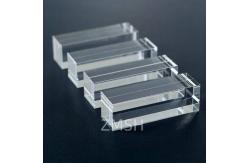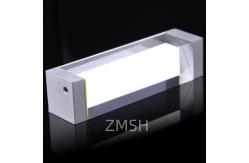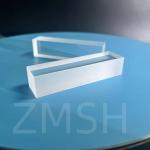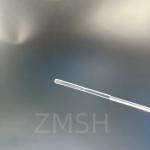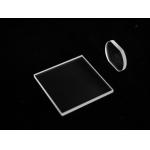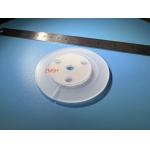Fused Quartz Optical Prisms UV/VIS Transmission Custom AnglesDefinition of Fused Quartz Optical PrismsA prism is an optical element in which one or more reflective
surfaces are ground into a single piece of glass. It functions to
redirect light paths, invert or rotate images, and can be
considered as a combination of planar mirrors. Prisms are widely
used in laser research, laser optical systems, optical imaging,
machine vision, life sciences, and biomedical applications or
products. Prisms can not only deflect light but also adjust image
orientation. The design of a prism determines how it interacts with
light. When light enters a prism, it may reflect off one or more
surfaces before exiting, or it may be refracted as it passes
through the prism.
Features of Fused Quartz Optical Prisms | Type | Features |
|---|
| Right-Angle Prism | 1. Deviates light path by 90° or 180°
2. Used in image/light path redirection | | Wedge Prism | 1. When used alone, deflects the beam by a specific angle
2. When used in pairs, enables beam shaping or deviation control | | Pentaprism | 1. Deviates light path by 90°
2. Maintains image orientation without inversion or reflection | | Dove Prism | 1. Rotates the image by twice the prism’s rotation angle
2. Output beam remains aligned with the original beam direction | | Hollow Roof Mirror (Reflective) | 1. Deviates light path by 180°
2. Reflective surface is coated with aluminum |
Description of Fused Quartz Optical Prisms 1. Right-Angle PrismA right-angle prism is commonly used to redirect the light path or
deflect the image formed by an optical system by 90°. Depending on
the orientation of the prism, the resulting image may appear
laterally correct but vertically inverted. Right-angle prisms are
also applied in image combination and beam displacement. When light enters through one of the right-angle faces, it
undergoes total internal reflection at the hypotenuse surface
(interface with air) and exits through the other right-angle face,
resulting in a 90° deviation.
When light enters through the hypotenuse surface, it experiences
total internal reflection at both right-angle faces (interfaces
with air) and exits back through the hypotenuse after being
deviated by 180°. 2. Wedge PrismWhen used individually, a wedge prism can deflect a normally
incident light beam on its vertical surface by a certain angle. The
deflection angle depends on the wedge angle—different wedge angles
result in different beam deviations. When the beam remains
stationary and the wedge prism is rotated, it can produce a
circular scanning output of the beam. A pair of wedge prisms can steer the beam to any position within a
full-angle 4θd circle, where θd is the deviation angle of a single
prism. This beam steering is achieved by independently rotating the
two wedge prisms. It is commonly used in imaging applications to
scan the beam to various positions, enabling precise beam control. 3. PentaprismA pentaprism reflects incoming light twice within the prism,
changing its direction by exactly 90°. The image remains upright
and retains its original handedness (no inversion or mirroring).
Compared to a single-reflection right-angle prism, a pentaprism can
precisely deflect the incoming beam by 90°, regardless of the
prism's mounting orientation. This makes it more stable than a
system composed of two mirrors, as it eliminates sensitivity to the
angle of incoming light. As a result, pentaprisms are commonly used in various optical
observation and calibration instruments, such as theodolites,
collimators, and rangefinders. In DSLR cameras, the viewfinder's
reflex system also uses a pentaprism to redirect the optical path
at a fixed angle. 4. Dove PrismThe Dove prism has unique optical properties. When light enters
from the slanted face, the output beam maintains its original
direction but forms an inverted image. If the prism is rotated by
an angle θ, the resulting image rotates by 2θ. When light enters
from the bottom surface of the prism, the beam is reflected back in
the opposite direction, also producing an inverted image. The Dove prism performs best when used with collimated (parallel)
light. If the incoming beam is convergent, astigmatism may be
introduced, which degrades image quality. Additionally, because
total internal reflection occurs within the Dove prism, a phase
difference arises between the s- and p-polarized components, which
can affect the polarization state of the transmitted beam. 5. Hollow Roof Mirror PrismThe hollow roof mirror prism reflects light that enters from the
slanted surfaces of the prism. Unlike flat mirrors, the reflected
beam remains parallel to the incident beam but is laterally
displaced, avoiding issues caused by beam interference. The two angled surfaces of the right-angle prisms are fixed at a
precise angle, making the setup much more convenient and accurate
compared to manually aligning two separate mirrors to achieve
parallel beam reversal.
Applications of Fused Quartz Optical Prisms Quartz prisms are widely used in precision optical systems due to
their excellent UV transmission, thermal stability, chemical
resistance, and low birefringence. Their ability to precisely
manipulate light paths through refraction and reflection makes them
ideal for high-performance optical applications. Key application
areas include: 1. Laser and Optical Systems- Used to redirect, split, or combine laser beams with high precision
- Ideal for high-power laser systems due to quartz's high damage
threshold
- UV-grade quartz prisms are essential in excimer laser setups and
beam steering assemblies
2. Spectroscopy and Analytical Instruments- Serve as dispersive elements in spectrometers for separating
wavelengths
- UV-transparent quartz prisms are used in fluorescence and
absorption spectroscopy
- Enable precise angle-dependent analysis of optical signals in
scientific instruments
3. Imaging and Vision Systems- Correct and manipulate image orientation in microscopes, cameras,
and telescopes
- Employed in pentaprisms, right-angle prisms, and Dove prisms for
image rotation or redirection
- Common in machine vision, biomedical imaging, and inspection
systems
4. Photonics and Communication- Quartz prisms serve as polarization rotators, beam steering
elements, or wavelength separators in fiber optic and photonic
circuits
- Used in the design of optical isolators and modulators due to
quartz’s stable refractive index
5. Metrology and Alignment Tools- Integrated into autocollimators, alignment scopes, and surveying
instruments for accurate angle measurement and beam deviation
- Provide reliable reference angles in interferometry and calibration
systems
6. Aerospace and Harsh Environment Optics- Quartz prisms operate reliably in vacuum, high-radiation, and
high-temperature environments
- Used in satellite imaging, spaceborne spectroscopy, and defense
optics systems
FAQ of Fused Quartz Optical PrismsQ1: What is a quartz prism and how is it different from standard
glass prisms?
A1:
A quartz prism is an optical prism made from high-purity
crystalline or fused quartz (SiO₂), known for its excellent UV
transmission, thermal stability, and chemical resistance. Compared
to standard glass prisms (e.g., N-BK7), quartz prisms can operate
in deeper UV ranges, withstand higher temperatures, and are more
suitable for harsh or high-energy environments. Q2: What wavelength range can quartz prisms transmit?
A2:
Quartz prisms offer a wide transmission range, typically from 180
nm (deep UV) to 2.2 μm (near-infrared). This makes them ideal for
ultraviolet lasers, fluorescence spectroscopy, and IR beam
steering. Q3: Are quartz prisms resistant to high temperatures?
A3:
Yes. Quartz has a high thermal stability with a softening point
around 1,620°C and excellent resistance to thermal shock. This
makes quartz prisms suitable for high-power laser optics and
high-temperature measurement systems. Related products
Quartz Glass Window UV Fused Silica Optical Viewport Custom Size
Coating Available Quartz Prisms UV Grade Beam Steering Optics for Laser and Imaging
Systems About Us ZMSH specializes in high-tech development, production, and sales of
special optical glass and new crystal materials. Our products serve
optical electronics, consumer electronics, and the military. We
offer Sapphire optical components, mobile phone lens covers,
Ceramics, LT, Silicon Carbide SIC, Quartz, and semiconductor
crystal wafers. With skilled expertise and cutting-edge equipment,
we excel in non-standard product processing, aiming to be a leading
optoelectronic materials high-tech enterprise. Packaging & Shipping Information Packaging Method: - All items are securely packed to ensure safe transit.
- Packaging features anti-static, shock-resistant, and dust-proof
materials.
- For sensitive components such as wafers or optical parts, we adopt
cleanroom-level packaging:
- Class 100 or Class 1000 dust protection, depending on product
sensitivity.
- Customized packaging options are available for special
requirements.
Shipping Channels & Estimated Delivery Time: - We work with trusted international logistics providers, including:
UPS, FedEx, DHL - Standard lead time is 3–7 business days depending on the
destination.
- Tracking information will be provided once the order is dispatched.
- Expedited shipping and insurance options are available upon
request.
|

